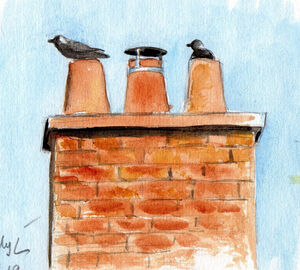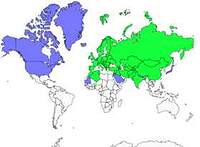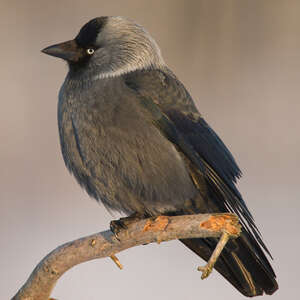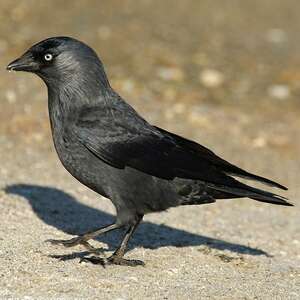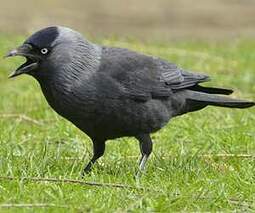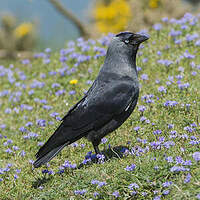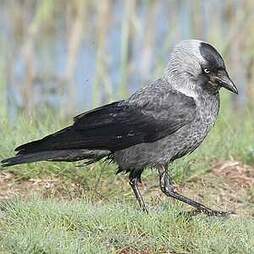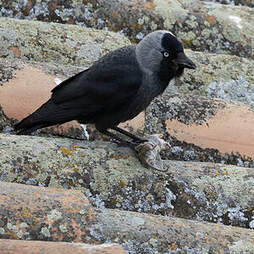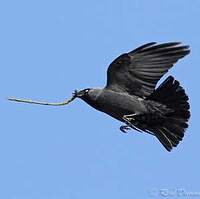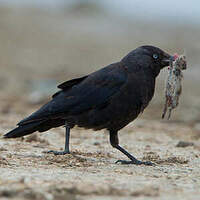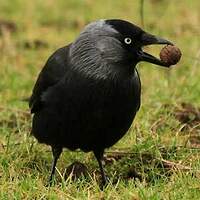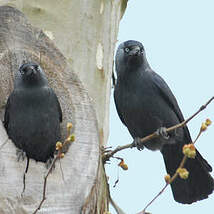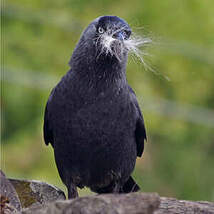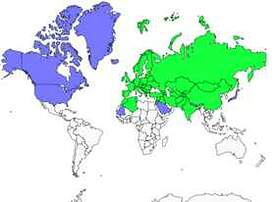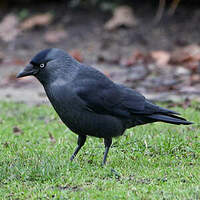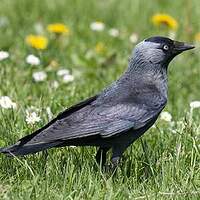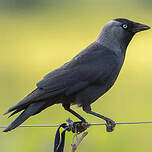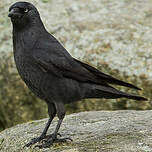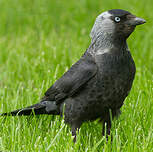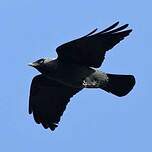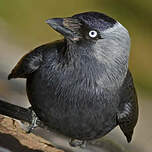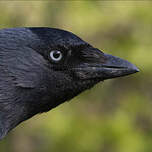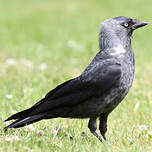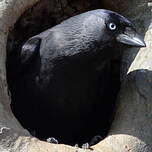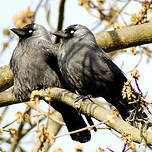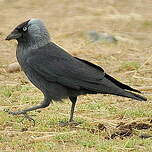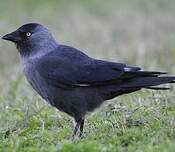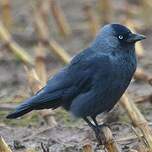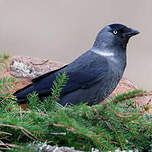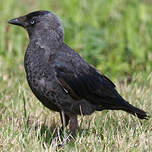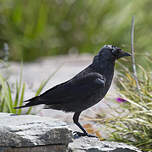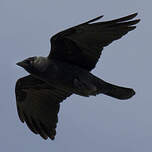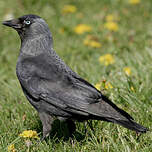Western Jackdaw
Coloeus monedula - Choucas des tours
Identification
The Western Jackdaw is the smallest of our native black corvids. It often accompanies the Carrion Crow and the difference in size is striking, both at rest and in flight. From a distance it appears black like the crow or the Rook, but up close in good light it can be seen that the body is rather bluish black while the crown, wings and tail are distinctly black, with a glossy black. An adult of the European sub-species spermologus of the West and South has the sides of the head and the neck clearly greyish. The white iris stands out well against this dark background. The black bill is very short and covered at the base with smooth feathers. The legs are black. The juvenile has a dark iris and the plumage tinged with brownish and dull. There are 4 subspecies. The northern European subspecies monedula is distinguished by its body which is slightly lighter grey and above all by the outline of a white collar at the base of the neck. The eastern subspecies soemmerringii is even paler. The head and neck are greyish ash, of course except for the crown of glossy black, and a distinct half white collar is seen at the base of the neck.
Subspecific information 4 subspecies
- Coloeus monedula monedula (Scandinavia)
- Coloeus monedula spermologus (w and s Europe, nw Africa)
- Coloeus monedula soemmerringii (e and se Europe to sc Siberia and w China)
- Coloeus monedula cirtensis (n Algeria)
Foreign names
- Choucas des tours,
- Grajilla occidental,
- gralha-de-nuca-cinzenta,
- Dohle,
- csóka,
- Kauw,
- Taccola,
- kaja,
- Kaie,
- kavka tmavá,
- kavka obecná,
- Allike,
- naakka,
- gralla occidental,
- Dvergkráka,
- kawka (zwyczajna),
- kovārnis,
- kavka,
- Галка,
- ニシコクマルガラス,
- 寒鸦,
- kaja,
- 寒鴉〔西方寒鴉〕,
Voice song and call
The Western Jackdaw has a voice that is distinctly different from the crow and the raptor. He does not croak. The usual cry is a loud kiak, going to a kiah kiah... when repeated in excitement. These cries are given both when it is perched and when it is flying. Also noted are longer and harsher kiiiaaarrh in the exchanges between individuals, the typical chattering of the family.
Habitat
The Western Jackdaw is a bird of open plains with scattered trees. It is not a forest bird at all. Originally, it must have frequented wooded steppes and nested in hollow trees.
Behaviour character trait
The Western Jackdaw is a sociable, lively and noisy bird. It is rarely seen alone. What immediately strikes when observing a flock of jackdaws in flight is their organization.
It is noticeable that the birds form pairs. The jackdaw is in fact monogamous and the couples are permanent, like many other corvids. The jackdaw willingly associates with other corvids, particularly the Carrion Crow. At the end of reproduction, they spend the night together in large dormitory trees for the safety of predators like the Eurasian Hobby. Such dormitories can gather thousands of crows and hundreds of jackdaws. Urban parks are often chosen for their calm. They also forage together, always with a security perspective. North-eastern birds chased by cold and snow can also migrate together towards the southern wintering areas. Finally, occasionally, the two species can nest together, crows in high branches, jackdaws in cavities, old tree groves. The habit of the jackdaw to nest in chimneys, both in the city and in the countryside, can pose a problem when the chimneys are active. The bird collects all sorts of material for its nest until it completely obstructs the conduit which can no longer play its role. And it is in the following autumn, when heating is switched on again, that one realizes that the chimney does not draw any more. The simplest way to avoid this problem is to cover the chimney with an anti-jackdaw grille.Flight
The flight of the Western Jackdaw is an easy and often acrobatic flight. Its ease is especially noticeable in collective air games, which are frequent. When it goes out scavenge or returns, the flight is direct and fast thanks to broad and jerky beats. Even migrants in transit fly in a direct line. We often see it taking advantage of updrafts with other Corvids, and climbing high into the sky.
Dietfeeding habits
The Western Jackdaw is an omnivore. Its diet must be quite comparable to that of the magpie, mainly vegetarian throughout the year (various seeds, berries, young shoots) but much more carnivorous during the breeding and insect abundance period, particularly for feeding young.
All available large insects, such as beetles, lepidoptera, orthoptera, tipula, etc. can be captured. It is an opportunist. It is known, for example, as a robber of eggs, for example in seabird colonies on the coast, or in the city with the eggs of pigeons. This rather shy bird can become confident in a favorable environment and come to eat the food that people throw at it. On the less shining side, the frequentation of treatment centers, a meeting point of all the consumers of the region, other corvidae, starlings, larids, kites, Grey Herons and even White Storks.Reproduction nesting
The Western Jackdaw is a monogamous, semi-colonial and cave-nesting species. It does not form dense colonies, due to the lack of suitable cavities.
The cavities can vary, from holes in old trees to crevices in natural or artificial cliffs, chimneys or other cavities in old buildings, hollow spaces in modern ERDF pylons, etc. The nesting period begins in April in the south of the range, and only in May-June for migratory populations. Both adults participate in construction. The size of the nest depends on the size of the cavity. If it is large, the nest can take large proportions. It includes a large base of twigs that are driven into the cavity and cemented with mud or cow dung. Then come heterogeneous objects, herbs and other plant elements, feathers, hair and bristles, rags... One can imagine the problem when it is a chimney that has been chosen for the nest, especially since it can be reoccupied for several years. The female usually lays 4 eggs (from 3 to 8) and incubates them for 17 to 19 days. The young, fed by both parents, fly away at the age of 1 month. After which, the gregariousness pushes the family groups to gather and pursue their occupations together.Geographic range
The Western Jackdaw is spread from the Atlantic facade (from Scandinavia to Morocco) to the west of Mongolia and China to the medium latitudes. Spermologus is the westernmost subspecies. This is the one that is found in France. It is distributed from the British Isles to Italy and Maghreb. Further to the north and northeast to the west of Russia is the ssp type monedula. Finally, the best distributed, soemmerringii, covers all of the south of the area, from southeastern Europe to western China, passing through Anatolia, the Middle East and Central Asia. The jackdaws of temperate zones are sedentary while those in the more northeast regions, subjected to winter hardships, are migratory and come to winter with the sedentary, or even beyond the nesting area to the east.
Threats - protection
IUCN conservation status
concern
in the Wild
threatened
evaluated
The Western Jackdaw is not an endangered species. It is common in many regions but is still given as declining in recent periods in various European countries.
Sources of information
- IOC World Bird List (v14.2), Gill, F and D Donsker (Eds). 2024-04-18.
- Les passereaux d'Europe, tome 1, P. Géroudet, M. Cuisin
- Birds of the World, The Cornell Lab of Ornithology
- xeno-canto, Sharing bird sounds from around the world,
Other sources of interest
 Specification sheet created on
10/07/2023 by Jean François
Specification sheet created on
10/07/2023 by Jean FrançoisTranslation by AI Oiseaux.net
© 1996-2025 Oiseaux.net
- Accipitriformes
- Aegotheliformes
- Anseriformes
- Apodiformes
- Apterygiformes
- Bucerotiformes
- Caprimulgiformes
- Cariamiformes
- Casuariiformes
- Charadriiformes
- Ciconiiformes
- Coliiformes
- Columbiformes
- Coraciiformes
- Cuculiformes
- Eurypygiformes
- Falconiformes
- Galliformes
- Gaviiformes
- Gruiformes
- Leptosomiformes
- Mesitornithiformes
- Musophagiformes
- Nyctibiiformes
- Opisthocomiformes
- Otidiformes
- Passeriformes
- Pelecaniformes
- Phaethontiformes
- Phoenicopteriformes
- Piciformes
- Podargiformes
- Podicipediformes
- Procellariiformes
- Psittaciformes
- Pterocliformes
- Rheiformes
- Sphenisciformes
- Steatornithiformes
- Strigiformes
- Struthioniformes
- Suliformes
- Tinamiformes
- Trogoniformes

